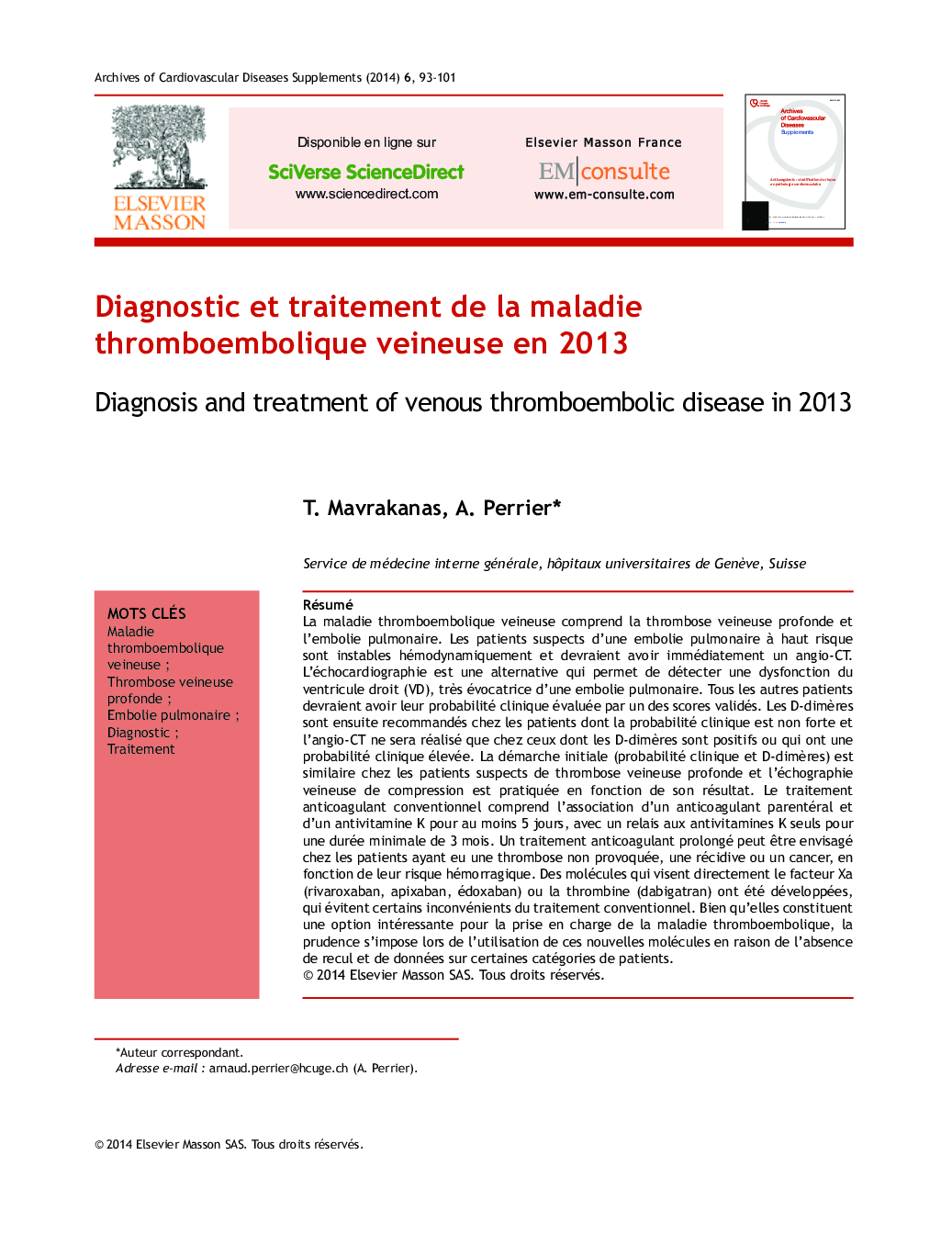| کد مقاله | کد نشریه | سال انتشار | مقاله انگلیسی | نسخه تمام متن |
|---|---|---|---|---|
| 2890946 | 1574435 | 2014 | 9 صفحه PDF | دانلود رایگان |
RésuméLa maladie thromboembolique veineuse comprend la thrombose veineuse profonde et l’embolie pulmonaire. Les patients suspects d’une embolie pulmonaire à haut risque sont instables hémodynamiquement et devraient avoir immédiatement un angio-CT. L’échocardiographie est une alternative qui permet de détecter une dysfonction du ventricule droit (VD), très évocatrice d’une embolie pulmonaire. Tous les autres patients devraient avoir leur probabilité clinique évaluée par un des scores validés. Les D-dimères sont ensuite recommandés chez les patients dont la probabilité clinique est non forte et l’angio-CT ne sera réalisé que chez ceux dont les D-dimères sont positifs ou qui ont une probabilité clinique élevée. La démarche initiale (probabilité clinique et D-dimères) est similaire chez les patients suspects de thrombose veineuse profonde et l’échographie veineuse de compression est pratiquée en fonction de son résultat. Le traitement anticoagulant conventionnel comprend l’association d’un anticoagulant parentéral et d’un antivitamine K pour au moins 5 jours, avec un relais aux antivitamines K seuls pour une durée minimale de 3 mois. Un traitement anticoagulant prolongé peut être envisagé chez les patients ayant eu une thrombose non provoquée, une récidive ou un cancer, en fonction de leur risque hémorragique. Des molécules qui visent directement le facteur Xa (rivaroxaban, apixaban, édoxaban) ou la thrombine (dabigatran) ont été développées, qui évitent certains inconvénients du traitement conventionnel. Bien qu’elles constituent une option intéressante pour la prise en charge de la maladie thromboembolique, la prudence s’impose lors de l’utilisation de ces nouvelles molécules en raison de l’absence de recul et de données sur certaines catégories de patients.
SummaryVenous thromboembolic disease comprises deep vein thrombosis and pulmonary embolism. Patients suspected of high-risk pulmonary embolism are unstable and should undergo CT angiography immediately and be managed accordingly. Bedside echocardiography is an alternative with signs of right ventricular dysfunction being highly suggestive of pulmonary embolism. For patients with suspected non-high risk pulmonary embolism, clinical probability should be assessed by validated clinical scores. Plasma D-dimer should be assayed in all patients with a non-high clinical probability and a negative result safely rules out pulmonary embolism. Patients with a positive result or a high probability undergo CT angiography. The initial approach to suspected deep vein thrombosis (clinical probability and D-dimer) is similar and should be followed by lower limb venous compression ultrasonography accordingly. Conventional anticoagulant treatment begins with concomitant administration of a parenteral anticoagulant (heparin or fondaparinux) and a vitamin K antagonist for at least five days, the latter being continued for at least three months. Extended treatment beyond three months may be considered in patients with an unprovoked event, a recurrence or cancer, according to the bleeding risk. New oral agents that directly target either factor Xa (rivaroxaban, apixaban or edoxaban) or thrombin (dabigatran) avoid many of the inconveniencies of traditional treatment. All of these agents have now been studied both for initial and extended treatment and have been shown to be non-inferior to traditional treatment. Although these agents are an attractive option, experience is still lacking for many patient subgroups and they should be used with caution while awaiting more data.
Journal: Archives of Cardiovascular Diseases Supplements - Volume 6, Issue 2, March 2014, Pages 93-101
